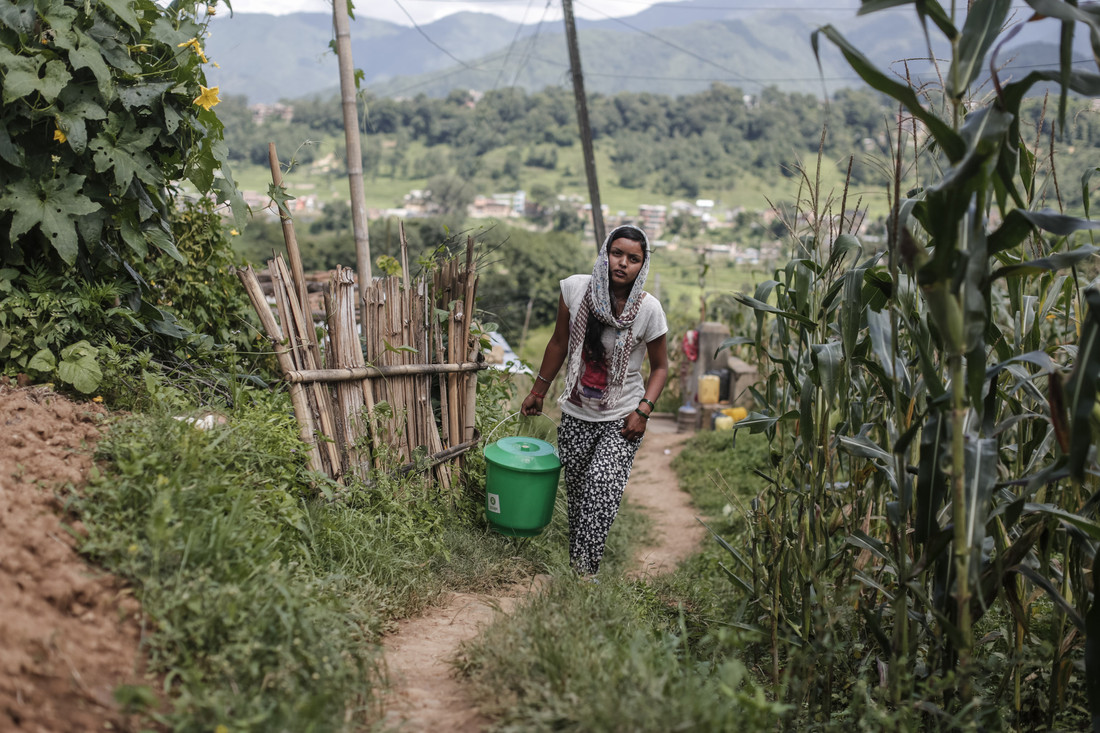Rebuilding Nepal
Ram Prasad Sapkota (62) of Tripureshwor VDC, 35 km from HQ Dhadingbesi of Dhading district mends his house, which collapsed during the earthquake measuring 7.8 on the Richter scale in April 25 2015. He is one of the earthquake survivors who received rice seeds distributed by Oxfam and our partner, Small Farmer Agricultural Cooperative Federation (SFACF). Credit Jes Aznar / Oxfam.
On 25th April 2015 a massive earthquake struck Nepal between the capital of Kathmandu and the city of Pokhara, killing thousands and causing widespread devastation.
Hundreds of thousands of people fled their homes fearing aftershocks and gathered in the surrounding areas, some in makeshift camps. Transport and communications were severely disrupted. Just over two weeks later on 12th May, a second earthquake of a similar magnitude caused further devastation. As a result, more than 8,900 people died, over 23,500 were injured and more than 800,000 houses were destroyed or damaged. In total, over 8 million people across 31 districts were affected by the earthquake.
Our response
In the first few days after the first earthquake hit, Oxfam in Nepal immediately responded by providing lifesaving relief including food items and drinking water and by setting up temporary shelters and emergency latrines. Our priorities were to ensure that affected people had access to adequate humanitarian assistance and to prevent the outbreak of disease.
During the first weeks, we distributed staple food supplies, alongside rice seeds and agricultural tools for farmers. We managed to ship vital emergency supplies to Gorkha, near the epicenter of the quake, as well as providing tarpaulins, rice, water and sanitation equipment to other hard-hit rural districts. In Kathmandu Valley, we provided clean water and sanitation facilities to earthquake survivors living in some of the worst hit districts. Oxfam’s technical experts constructed water tanks and sanitation facilities in the temporary camps.
By April 25th, 2017, thanks to our donors, Oxfam has:
- distributed close to 60,000 emergency and improved shelter kits benefitting over 322,00 people
- helped 17,000 farmers to access rice seeds to replenish destroyed supplies.
- constructed 8,000 latrines providing safer, more dignified living conditions.
- provided chlorinated water to 35,000 people.
- distributed cash vouchers to enable families to buy seeds, tools and other essential items, which in turn helps boost the local economy.
- provided over 6,000 Compassionate Grants to enable people to buy life saving food items or medicines.
- provided over 2,300 families with a Multi Purpose grant to restart existing businesses, to regenerate community infrastructure, and to support market and financial systems.
- supported over 14,000 families with Oxfam’s Cash for Work (CFW) programme, which provides short-term employment in the rebuilding of community services.
- Together we have reached over 534,000 people in need.
After the initial relief phase the focus shifts to recovery and reconstruction.
Now, our focus shifts from emergency relief to long-term recovery for Nepal. Thousands of people have benefited from Oxfam’s cash for work schemes, which gives them much needed income in return for repairing damaged water supplies and pathways connecting communities. Oxfam’s recovery grants help rebuild livelihoods and regenerate the community infrastructures. We are continuing to repair and restore longer term water and sanitation facilities in schools with separate toilets and wash areas for girls to encourage them to come to school.

Dhan Kumari Adhikari (32) of Tripureshwor VDC in Dhading district scatters the rice seeds in her field, preparing for paddy cultivation. A housewife and a mother of 2, Dhan Kumari received the seeds from Oxfam and our partner, Small Farmers Agriculture Cooperative after the rice stock seeds that she had stored away from her previous yield got mixed with rubble when her house collapsed during the earthquake. Credit Jes Aznar / Oxfam.
While Nepal continues the long road to recovery, Oxfam is urging the government to engage with communities in reconstruction and resettlement schemes to identify those in greatest need and to replace lost documents. “With monsoon rains fast approaching in Nepal, it is imperative that reconstruction is made both speedier and fairer,” said Oxfam country director Cecilia Keizer. "After such an overwhelming show of generosity, the people of Nepal deserve a fast and fair route to recovery."
How can you show your support?
By donating to Oxfam on a regular basis through our Shareplan monthly giving program, you are giving us the financial security we need to step in and save lives - whenever and wherever we're needed. Thank you for your ongoing commitment. Lives depend on it.
Learn More
Map: Oxfam works in 7 out of the 14 most affected regions in NepalOpens in a new window
Photo Book: The Year Nepal Shook
Publication: Nepal One Year on
Publication: Rebuilding a More Resilient Nepal: Key recommendations for reconstruction and recovery, October 2015
Update: Nepal 6-month Report, October 2015
Report: 3-month Update, July 2015
News Release: One month on, Oxfam reaching Nepal’s most isolated in a race against the monsoon, May 25, 2015
News Release: Devastating earthquakes in Nepal, May 12, 2015
News Release: Need for shelter in monsoons biggest concern in rural areas of Nepal, May 7, 2015
Blog: Nepal earthquake was 'single most frightening experience of my life', May 19, 2015
Blog: Fostering gender equality in emergencies, May 1, 2015
Blog: 3 things to know about how we’re helping in Nepal, April 30, 2015
Updated April 25, 2016